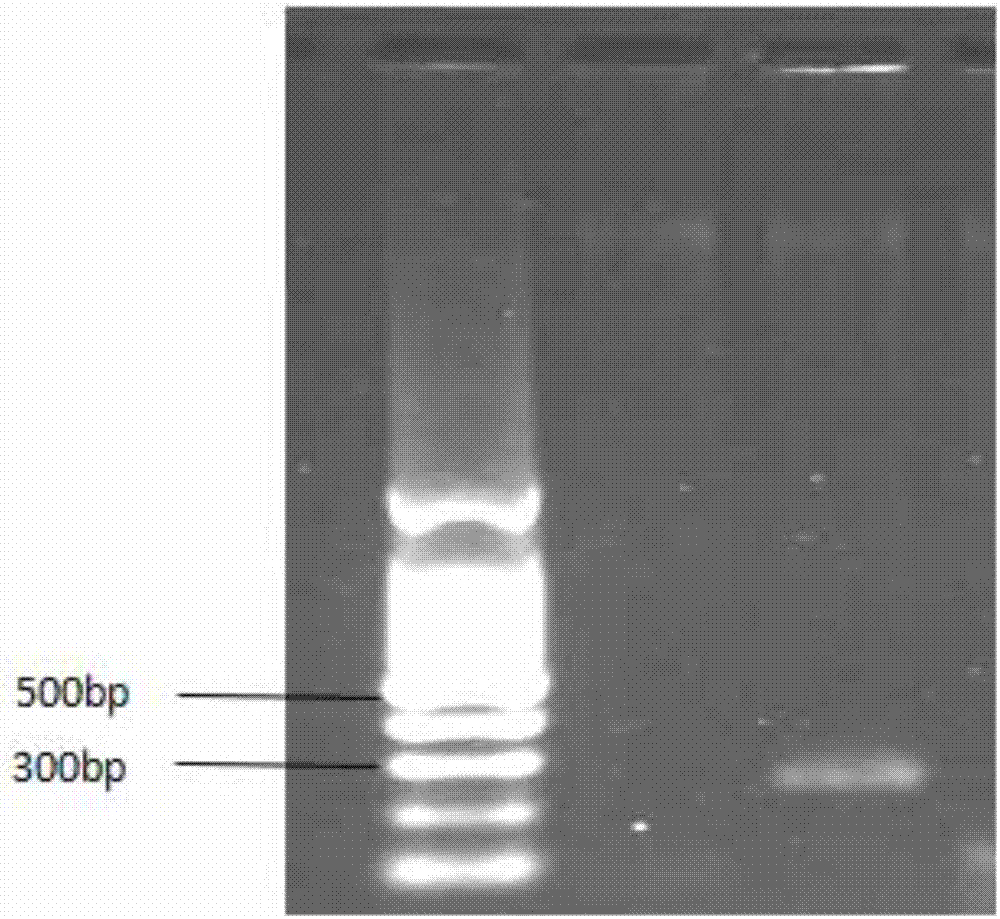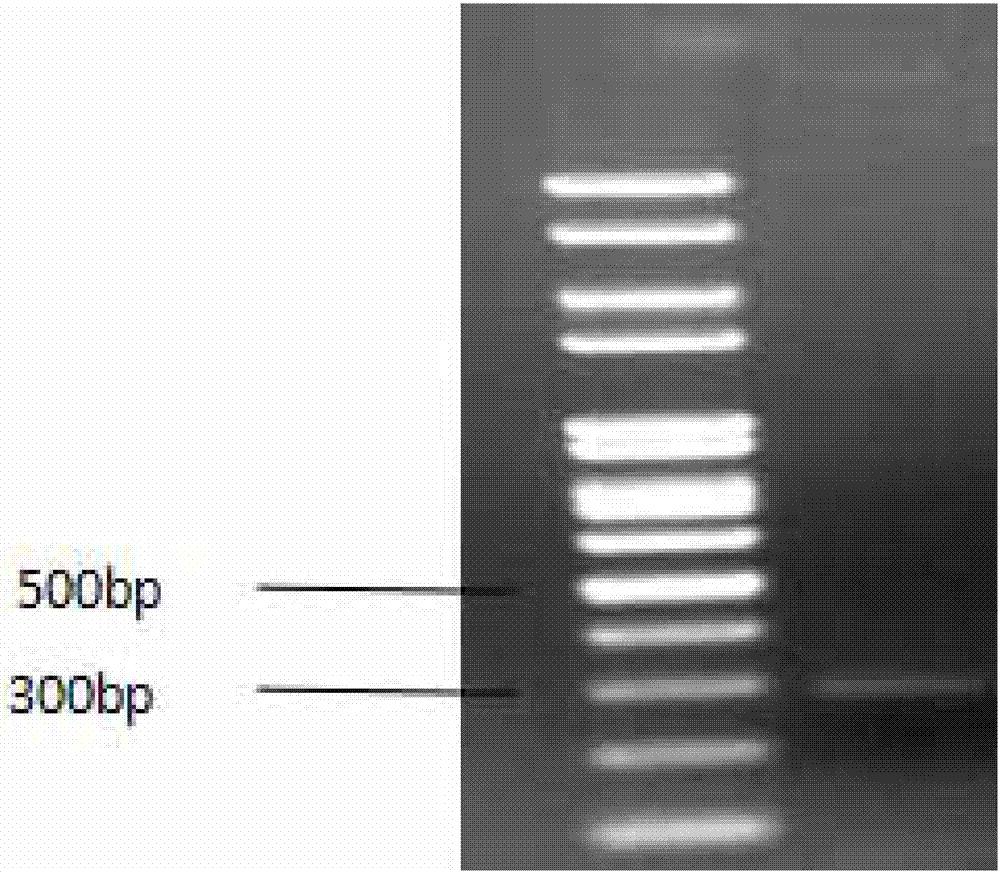Method for cultivating transgenic rice based on RNAi binary vector
A technology of transgenic rice and binary vectors, applied in genetic engineering, recombinant DNA technology, botany equipment and methods, etc., can solve problems such as human health and environmental hazards, improve inhibition efficiency, eliminate food safety concerns, and significantly economic value effect
- Summary
- Abstract
- Description
- Claims
- Application Information
AI Technical Summary
Problems solved by technology
Method used
Image
Examples
Embodiment 1
[0029] Embodiment 1 vector construction
[0030] 1. Rice genome extraction
[0031] Using the high-salt method to extract rice genomic DNA, cut out 1 g of rice (Nipponbare) tissue, grind it with liquid nitrogen, add 30 μL of DNA extraction solution, incubate in a water bath at 65°C for 12 minutes, add 30 μL (25:24:1 toluene:chloroform:isoamyl alcohol), Centrifuge to get the supernatant, add 250 μL isoamyl alcohol to shake and centrifuge, remove the phase, add 500 μL 75% ethanol, wash and centrifuge, add 20 μL TE buffer, and store at 4 °C.
[0032] 2. Primer Design
[0033] We selected some exon genes of Csn5 gene to design primers to obtain target gene fragments for constructing RNAi vectors. After adding Nco1 and Sal1 restriction endonucleases and protective bases, the primer sequence:
[0034] P1 is: CCCATGGGGAAGGTTGGAGAATGTGGTT;
[0035] P2 is: GCGTCGACACACCAAAAATCTTCTATCTTG;
[0036] 3. Using the above primers and the rice genome as a template, amplify the partial exo...
Embodiment 2
[0051] Example 2 Agrobacterium transfection
[0052] 1. Preparation and transformation of Agrobacterium competent cells
[0053] 1.1 Preparation of Agrobacterium Competent Cells
[0054] 1.1.1 Pick a single clone of Agrobacterium or pipette 50 μL of the preserved Agrobacterium solution into 5ml YEP (containing 50mg / LKan) culture solution, 28°C, 250rpm shaking culture for 24h to the OD of the bacteria solution 600 is 1.5;
[0055] 1.1.2 Transfer 2mL of the above bacterial solution to 200mL YEB (containing 25μg / ml rifampicin), culture at 200rpm, shaker at 28°C for 4 hours to OD 600 reach about 0.5;
[0056] 1.1.3 Transfer to a sterile centrifuge tube, centrifuge at 5000rpm for 5min, and discard the supernatant;
[0057] 1.1.4 Add 10mL of pre-cooled 0.1M CaCl 2 solution, gently suspend the cells, and place on ice for 20 min. Centrifuge at 5000rpm at 4°C for 5min, discard the supernatant;
[0058] 1.1.5 Add 5 mL of pre-cooled 0.1M CaCl containing 15% glycerol 2 solution, g...
Embodiment 3
[0064] Embodiment 3 transgenic rice cultivation
[0065] 1. Bacteria removal and hygromycin screening
[0066] Wash the co-cultured callus with sterile water for 4-5 times, then sterilize it with a medium containing Amp (500 mg / L), shake it on a shaker for about 15 minutes, and then use sterile filter paper to remove the callus. The tissue was blotted dry, placed on the screening medium (Hyg 30mg / L) for screening, about 20d, subcultured once every 10d;
[0067] 2. Differentiation
[0068] Transfer the resistant callus sifted out on the screening medium to the differentiation medium (Hyg 20mg / L) for differentiation, about 20d, subculture once every 10d;
[0069] 3. Rooting
[0070] The resistant callus that differentiated into green seedlings is about 1 cm, and transferred to the rooting medium for rooting, and a well-developed root system can grow in about 7 days;
[0071] 4. Seedling hardening
[0072] Put the seedlings in a fresh-keeping bag to carry out the adaptabilit...
PUM
 Login to View More
Login to View More Abstract
Description
Claims
Application Information
 Login to View More
Login to View More - R&D
- Intellectual Property
- Life Sciences
- Materials
- Tech Scout
- Unparalleled Data Quality
- Higher Quality Content
- 60% Fewer Hallucinations
Browse by: Latest US Patents, China's latest patents, Technical Efficacy Thesaurus, Application Domain, Technology Topic, Popular Technical Reports.
© 2025 PatSnap. All rights reserved.Legal|Privacy policy|Modern Slavery Act Transparency Statement|Sitemap|About US| Contact US: help@patsnap.com


